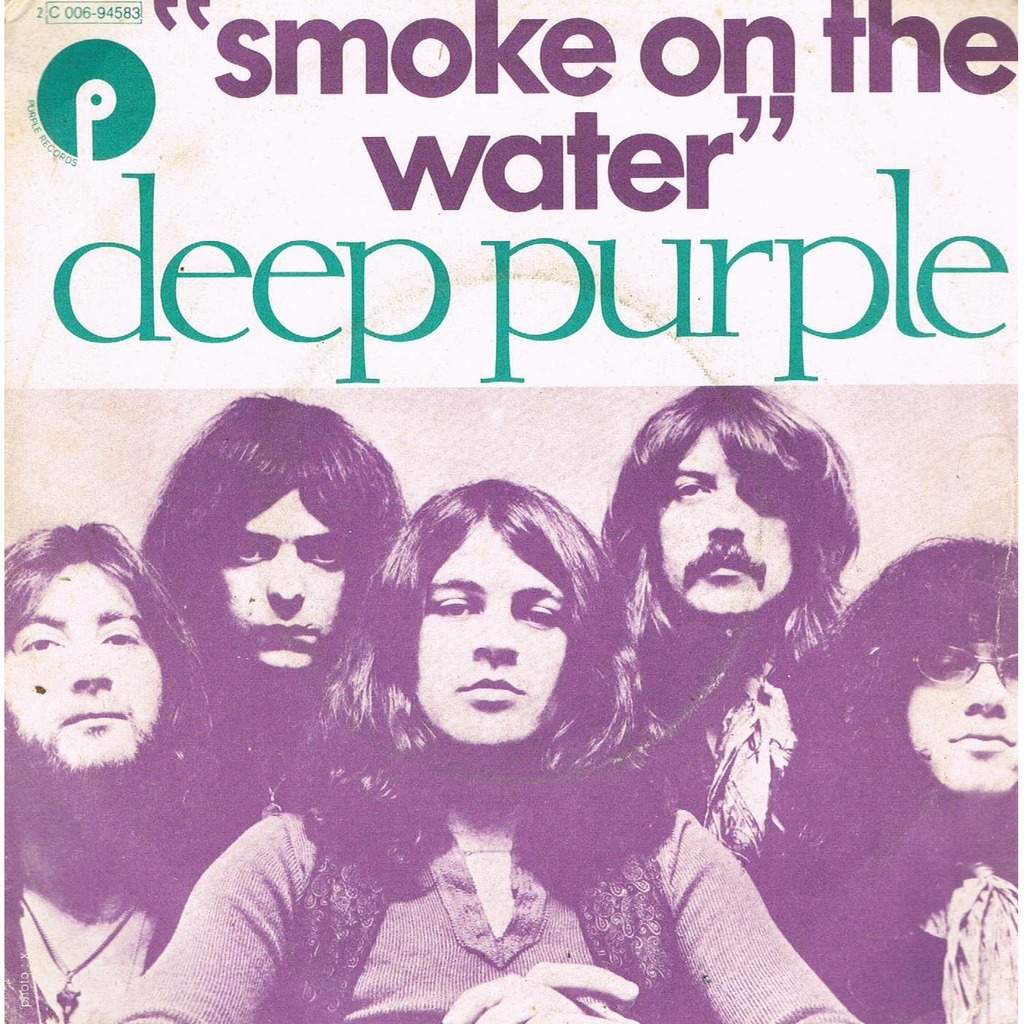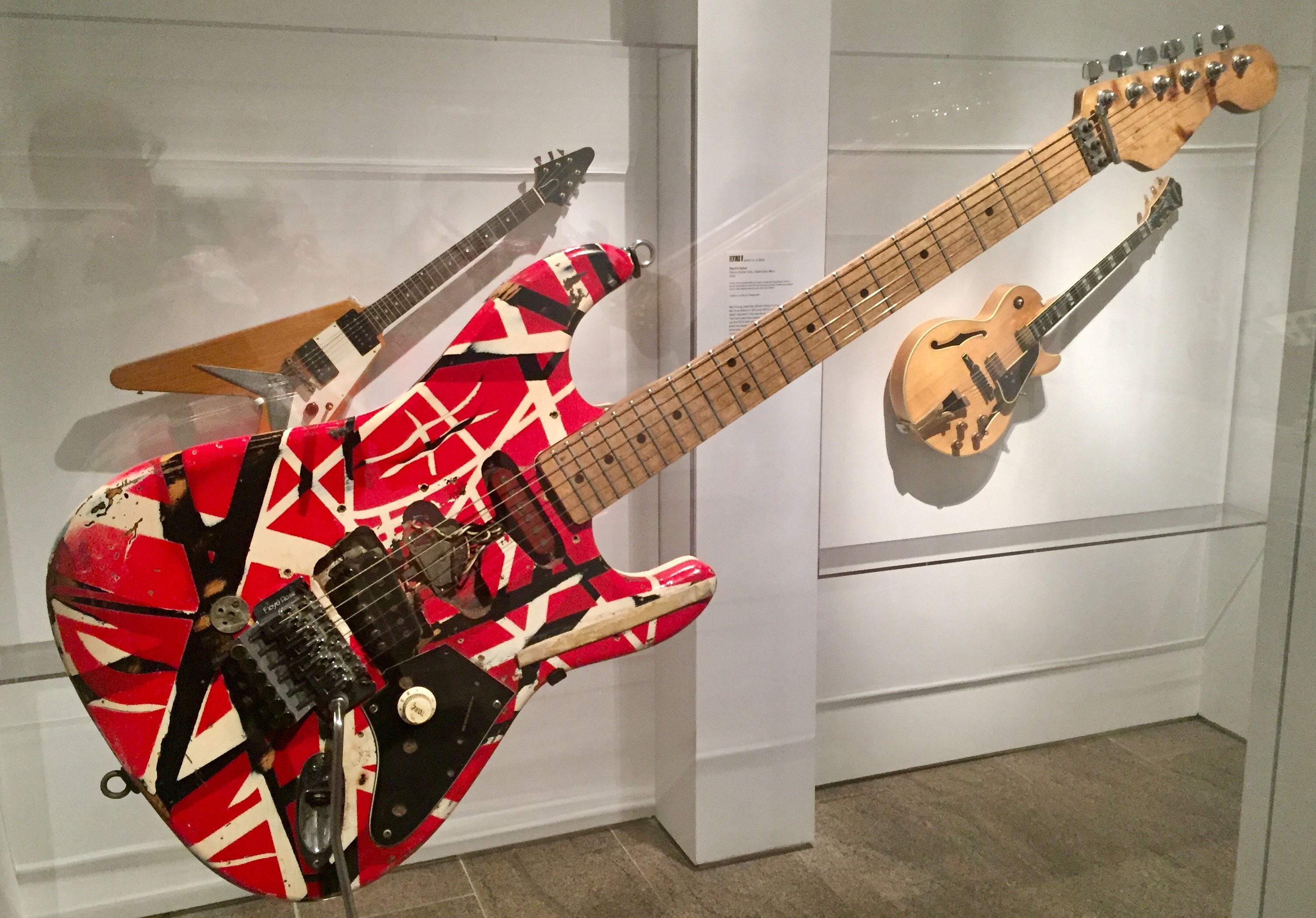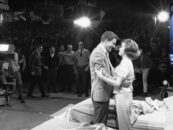
“Ritchie Blackmore’s lead is a thing of wonder”
Guitar maestros generally don’t go in for pissing matches or “best of” contests for the greatest guitar leads. Hendrix, for example, was all about humility and mutual respect in those late-night jams with Eric Clapton, Jeff Beck, Johnny Winter, Ronnie Wood or anybody who was around in places like The Scene or Ondine’s in New York, The Scotch of St. James in London or backstage at Monterey.
When Mike Bloomfield laid down his Les Paul after finishing the “Work Song” track on what was to become the Paul Butterfield Blues Band’s East-West album, he knew that he had come up with something special in the manner of a jazz combo like John Coltrane’s – the result of collaborative sparring with like-minded equals.

Eddie Van Halen’s “Frankenstrat” guitar at the Met Museum, NYC, 2019 (Photo: Greg Brodsky)
And when Edward Van Halen came up with the signature riff that identifies his oft-quoted mind-bender “Eruption,” he wasn’t aiming for a marker that would blow other players away – he was just having fun in the studio, experimenting with effects and fingering techniques. The solo, as he explains below, was quite a happy accident that almost didn’t make it onto the album.
Most of these lead-guitar spotlights began in the same spirit: collaboration and experimentation. In most cases, also, the result was a happy accident, which often might not have made it onto the album, but for a simple twist of fate.
11) Ron Wood on “Little Wing”
Covered by artists like Eric Clapton, Stevie Ray Vaughan and Sting, “Little Wing” is one of Jimi Hendrix’s most beautiful and enduring compositions. The original is seductively warm, poignant and light as a feather. “‘Little Wing’ is like one of these beautiful girls that come around sometimes,” explained Hendrix. “You ride into town for the drinks and parties and so forth. You play your gig; it’s the same thing as the olden days. And these beautiful girls come around and really entertain you. You do actually fall in love with them because that’s the only love you can have…. ‘Little Wing’ was a very sweet girl that came around that gave me her whole life and more if I wanted it. And me with my crazy ass couldn’t get it together, so I’m off here and there and off over there.”
Ron Wood’s homage, performed with The Corrs in Dublin 2009, is a brilliant rendition of this classic. Between 2:36, when he hits the strings on his Strat, till the end of his cosmic workout, the epiphany is all ours.
10) Joe Satriani on “Surfing With the Alien”
Joe Satch’s signature riff might not have happened at all but for some happy accidents. “We didn’t know where that song was going until one afternoon when we went to record the melody and I plugged a wah-wah pedal and a Tubedriver into my 100-watt Marshall,” Satriani told Guitar World when I edited a story on him. “Then, just on a whim, I said, ‘Let’s try this harmonizer,’ an Eventide 949. The sound that came out of the speakers blew us away so much that we recorded the melody and the solo in about a half-hour and sat back and went, ‘Whoa! This is a song, man!’
“And then, of course, the Eventide broke down and we couldn’t fix it. We couldn’t do anything. We lost our tone. When we finally got it working again, we weren’t able to recreate the original effect. It just sounded different. So rather than screw up a wonderful-sounding performance that may have had a couple of glitches, we decided to just leave it, because it was just swinging. It wasn’t until we finished that track and added the jet noises that we realized that ‘Surfing’ was the song that summed up the feeling of the whole album.”
Fun factoid: Joe Satch literally did not know anything about the comic book character, Marvel’s Silver Surfer, who graced the cover of his second album in 1987 that took its name from this song. The product manager at the record label used to be called the Silver Surfer, and he decided the image would go great with the album’s Surfing with the Alien title.
9) Neil Young on “Rockin’ in the Free World”
This song is about pounding out the message. In between chants come the guitar epiphanies, fueled by the strutting, bashing clamor of Neil twanging the Bigsby on his Les Paul Custom. He doesn’t get into the workout till 5:01, then he amps it up. If that is possible.
Fun factoids: The song has been used in Donald Trump’s 2016 and 2020 presidential campaigns. Young, a longtime supporter of Bernie Sanders, said that Trump’s use was not authorized. The song is featured as a playable track in Guitar Hero: Warriors of Rock.
8) Ritchie Blackmore on “Smoke on the Water”
Out of the ashes of a burned building in Montreux, Switzerland, “Smoke on the Water” was born, recorded with the Rolling Stones Mobile unit in a lonely hotel in the mountains. “We set up all the equipment in the corridor, with the drums and some amps tucked into alcoves,” Blackmore recalled. The signal reached the recording truck via a series of cables buried in the show. “I think that setup led to capturing some spontaneity, because once we got to the truck for a playback, even if we didn’t think it was a perfect take, we’d go, ‘Yeah, that’s good enough.’ Because we just couldn’t stand going back again [through the snow].”
Blackmore’s lead has a number of distinct sections in it, almost like a mini-suite. It truly is a thing of wonder.
7) Mike Bloomfield on “Work Song”
The Paul Butterfield Blues Band’s ambitious second album East-West was a mind-blowing signpost in the history of rock, with the band showing an effective command of jazz, Indian raga and garage-rockish proto-psychedelia as well as razor-sharp electric blues. The core of the band was the dueling guitar work of Mike Bloomfield and Elvin Bishop, especially Bloomfield’s ferocious, acrobatic solos, while Mark Naftalin’s keyboards added welcome washes of melodic color, and the rhythm section of bassist Jerome Arnold and drummer Billy Davenport were capable of both the rock-solid blues support and the more flexible pulse of a jazz combo. Bloomfield went into previously uncharted territory with the free-flowing jazz of Nat Adderley’s “Work Song.” Bloomie was one of those high-flying axemen who burnt out well before his time, but this performance will keep him forever on the edge of history.
6) Eddie Van Halen on “Eruption”
On the day this came out in 1978, it changed the way guitar would be played forever. Two-handed tapping, dive-bombing whammy bar dips, artificial harmonics and serious amp overdrive – Van Halen’s application of these and other techniques were added to the guitar lexicon in an “eruption” of astounding technique.
Another happy accident, the unaccompanied solo wasn’t even supposed to be on Van Halen, the band’s debut album. “While we were recording the album, I showed up at the studio early one day and started to warm up because I had a gig on the weekend and I wanted to practice my solo-guitar spot,” Van Halen explains. “Our producer, Ted Templeman, happened to walk by and he asked, ‘What’s that? Let’s put it on tape!’ I played it two times for the record, and we kept the one that seemed to flow. Ted liked it, and everyone else agreed that we should throw it on the album. I didn’t even play it right – there’s a mistake at the top end of it. Whenever I hear it, I always think, ‘Man, I could’ve played it better.’”
5) Billy Gibbons on “La Grange”
“A haw haw haw haw.”
Gibbons played the lead on this single from ZZ Top’s 1973 album Tres Hombres on a 1955 Fender Stratocaster with a stop tailpiece through a Marshall Super Lead 100 amp with Celestion greenback speakers. The initial groove of the song is based on a traditional boogie blues rhythm used by John Lee Hooker in “Boogie Chillen'” and by Slim Harpo in “Shake Your Hips.” A failed lawsuit by the copyright holder of “Boogie Chillen'” resulted in the court ruling that the rhythm was in the public domain.
Over the infectious rhythm, Gibbons delivers a lead that sounds like barbed wire carrying a high-voltage transmission.
Fun factoids: The beginning of the song was played by Billy Gibbons in an episode of Bones (“Stargazer in a Puddle” on Fox in 2007; season two finale). Gibbons played a character similar to himself whose daughter, forensic scientist regular in the cast Angela Pearly-Gates Montenegro-Hodgins – Pearly-Gates is from Gibbons’ guitar – is a regular on the Bones team.
The song refers to a brothel on the outskirts of La Grange, TX (well-known as “The Chicken Ranch,” where many young Texans lost their virginity). The first time ZZ Top played the song in La Grange was during the Fayette County Fair on September 5, 2015.
4) Mick Taylor on “Moonlight Mile”
Stones axemeister during the band’s golden period Mick Taylor built the song around a short guitar riff Keith Richards had written, adding chinoiserie – loosely translated as a Chinese influence on Western art – in the backing, from which Mick’s vocals would rise. It was also his idea to add the strings that give the track its epic heft. Taylor maintains that he was denied credit for his efforts; Richards and Jagger took full credit for the song on 1971’s Sticky Fingers.
The mesmeric arrangement all builds up to Taylor’s lead towards the end of the song – a masterpiece of potent understatement with an ingeniously imaginative melodic flow. It’s one you really have to make yourself tune into it to catch all the rewards it offers.
Fun factoid: The “Moonlight Mile” track was featured extensively during the final episode of the first part of the sixth season of The Sopranos, “Kaisha.”
3) Chuck Berry on “Johnny B. Goode”
Berry makes this look is easy to play, but of course no one can play it with the feeling Chuck Berry had, or with the duck walk for that matter. After all, it was Chuck Berry who defined the momentum of rock’n’roll with this song. Without “Johnny B. Goode,” there would likely be no Keith Richards. John Lennon might have turned out a whole lot differently, and much of what we have come to know as rock ‘n’ roll would be a vast wasteland, a Sargasso Sea of putrification. The single was recorded at Chess Studios in Chicago, on December 29 or 30, 1957, with Berry backed by a lean, swinging blues trio of Willie Dixon (bass), Lafayette Leake (piano) and Fred Below (drums).
The mid-song lead plays like how they used to describe Rice Krispies: lots of snap, crackle and pop. Plus ring and roar and further electric six-string colors, lines and chording that set a standard that many have aspired to in the decades to follow, but few have approached its witty construction and fervent execution.
Fun factoids: “Johnny B. Goode” was featured in the original Back to the Future, in which Marty McFly played this song at the “Enchantment Under the Sea Dance Party” when he time traveled back to 1955 – which was two years before the song was even recorded!
Thanks to the late astronomer Carl Sagan, Chuck is doing the duck walk across the universe. The song is incorporated into the Voyager 1 space probe, making its rockin’ way towards Neptune, some four-billion miles away.
2) Eric Clapton on “Crossroads”
Like I said up top, this is not your typical guitar leads list, and one thing my selections have in common is that they were not premeditated, not engineered to become classic lead guitar riffs. They often come to life as happy accidents. Such was indeed the case with Clapton’s solo on Cream’s radical reworking of bluesman Robert Johnson’s signature tune, “Crossroads.”
“It’s so funny, this,” Clapton told Guitar World in a story that I edited. “I’ve always had that held up as like, ‘This is one of the great landmarks of guitar playing.’ But most of that solo is on the wrong beat. Instead of playing on the two and the four, I’m playing on the one and the three and thinking, ‘That’s the off beat.’ No wonder people think it’s so good – because it’s fucking wrong.” [laughs]
The audio on the clip below is from the best version of “Crossroads” from the 1968 album Wheels of Fire, even though the video is from the live concert at Winterland, which was reportedly affected by the late arrival of one Ginger Baker to the gig, followed in hot pursuit by cop cars. But the band recovered and made blues lemonade of of lemons. The first guitar solo is pure genius. Ginger eventually begins to play the correct beat halfway through the solo, and the band seamlessly morphs into a synchronized unit.
1) Jimmy Page on “Whole Lotta Love“
So many Jimmy Page tracks to choose from but this one, without question, is Numero Uno. And the proof of the pudding is that I was there at Madison Square Garden in 1973 to witness it and have it be forever seared into my consciousness.
You need coolin’, baby, I’m not foolin’,
I’m gonna send you back to schoolin’….
And Pagey goes right into it. The riff echoes through the rafters of the Garden and we are off on a magic carpet ride of blues boogie.
But it’s the lead we’re talking about here. On the original album track it first soars and swirls like a fighter plane in a dogfight, and then finally wails in a workout with each note feeling like a whip snap. Live at the Garden, it’s an extended compendium of chording, experimental flights of fancy, and fleet-fingered lines that slice off the top of your skull.
The recording of the Song Remains the Same album and film took place during three nights of concerts at New York’s Madison Square Garden during the band’s 1973 North American tour. The album was released on October 22, 1976 by Swan Song Records. The sleeve design depicted a dilapidated movie house located on Old Street in London, which was used by the group for rehearsals prior to their 1973 tour.
Related: Part 1 of our story
- 10 Great Rock Driving Songs - 08/28/2025
- 10 Great Eric Clapton Collaborations - 03/29/2025
- 11 Movies That Rock: Woodstock to Spinal Tap - 03/01/2025






4 Comments so far
Jump into a conversationI would never consider Neil Young as a guitarist.
I agree with you. Frankly, I think Neil Young is perhaps the most overrated “musician” ever. His stuff has always left me cold. He has a horrible, whiny, off-putting singing voice and his guitar playing is often like Jack White’s: just a bunch of noise.
While I think this article is misguided in the first place. IMO, you cited as many misses as you did hits. Trying to quantify music, or any part of is ludicrous and so subjective as to be useless. Trying to always quantify everything in the US is probably one of our biggest failings, as it orients people to the idea that a “best” exists in things that, as you said in your own article, were not meant competitively in the first place. This site is better than this and should be above such adolescent BS.